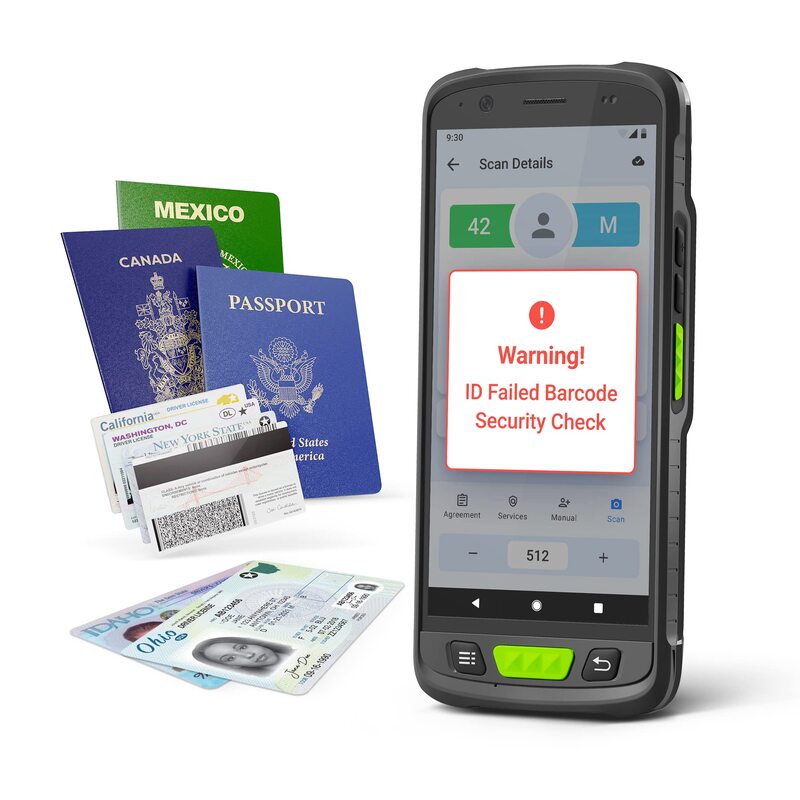My business uses electronic scanning devices to verify an id is valid? In an era where identity verification is crucial for various business operations, the use of electronic scanning devices has become increasingly popular. These devices offer an efficient and secure way to validate IDs, helping businesses comply with legal requirements and preventing fraud. Therefore, understanding the significance of electronic scanning devices and their application can greatly enhance your business operations. This article provides an in-depth look into how these devices work, their benefits, and best practices for implementation. By leveraging electronic scanning devices, businesses can ensure the validity of IDs while streamlining customer interactions.
How Electronic Scanning Devices Work
Electronic scanning devices are sophisticated tools designed to verify the validity of a wide range of identification documents. Therefore, understanding their functionality is essential to appreciate their effectiveness.
The Technology Behind Scanning Devices
My business uses electronic scanning devices to verify an id is valid? The technology behind electronic scanning devices involves advanced software and hardware components that work together seamlessly. These devices use optical character recognition (OCR) to read and interpret the data encoded in IDs, such as driver’s licenses and passports. Additionally, they can decode barcodes and read magnetic strips, extracting the required information instantaneously. Coupled with databases that store verified records, these devices can cross-check the scanned data against existing databases for validation. Therefore, the technology behind scanning devices ensures accurate and reliable ID verification.
Types of Electronic Scanning Devices
There are several types of electronic scanning devices catering to different needs and environments. Handheld scanners are portable and easy to use, ideal for mobile verification scenarios like events or security checkpoints. Fixed scanners are typically placed at entry points or counters, providing a more permanent solution for locations like bars, clubs, or government offices. Integrated scanners are part of a larger system, often used in airports and large institutions requiring multi-layered security measures. Therefore, understanding the types of scanning devices helps businesses choose the right tool for their specific requirements.

Benefits of Using Electronic Scanning Devices
Utilizing electronic scanning devices for ID verification offers multiple benefits that enhance both security and efficiency. Therefore, exploring these advantages can help justify the investment in such technology.
Enhanced Security
One of the primary benefits of electronic scanning devices is the enhanced security they provide. By accurately verifying IDs, these devices help prevent fraudulent activities and unauthorized access. The ability to cross-check data against databases ensures that only valid IDs are accepted, reducing the risk of identity theft and falsification. Furthermore, many devices can detect tampering or alterations in the ID, providing an additional layer of security. Therefore, the enhanced security offered by electronic scanning devices is invaluable for businesses and organizations.
Improved Efficiency
In addition to security, electronic scanning devices significantly improve operational efficiency. Manual verification processes can be time-consuming and prone to human error, leading to delays and inaccuracies. Electronic scanners automate the verification process, providing instant feedback on the validity of IDs. This speed not only enhances customer experience by reducing wait times but also allows employees to focus on other tasks. Therefore, the improved efficiency provided by these devices enhances overall business operations.
Implementing Electronic Scanning Devices in Your Business
My business uses electronic scanning devices to verify an id is valid? Implementing electronic scanning devices effectively requires careful planning and execution. Therefore, following best practices ensures a smooth integration into your business operations.
Staff Training
Staff training is a crucial step in implementing electronic scanning devices. Employees need to understand how to operate the devices correctly to ensure accurate and reliable ID verification. Training sessions should cover the basics of using the devices, interpreting the results, and troubleshooting common issues. Additionally, employees should be aware of the legal requirements and consequences of failing to verify IDs properly. Therefore, comprehensive staff training is essential for the effective use of electronic scanning devices.
Integrating with Existing Systems
Integrating electronic scanning devices with your existing systems enhances their effectiveness and utility. Many businesses already use point-of-sale (POS) systems, customer relationship management (CRM) software, and security systems. Ensuring that the scanning devices are compatible and can share data seamlessly with these systems streamlines operations. This integration allows for centralized data management, better reporting, and enhanced security measures. Therefore, integrating scanning devices with existing systems is a best practice for maximizing their benefits.

Challenges and Solutions
Despite the numerous benefits, businesses may face challenges when implementing electronic scanning devices. Therefore, understanding common challenges and their solutions is crucial for a smooth transition.
Technical Issues
One common challenge is the potential for technical issues with the scanning devices. Malfunctions, software glitches, or connectivity problems can disrupt the verification process and frustrate both employees and customers. To mitigate these issues, it is essential to invest in high-quality devices from reputable manufacturers. Regular maintenance and updates are also crucial for ensuring the devices function correctly. Therefore, addressing technical issues proactively ensures the reliability of electronic scanning devices.
Compliance with Regulations
Another challenge is ensuring compliance with legal regulations regarding data privacy and ID verification. Different jurisdictions may have varying requirements for data storage, handling, and reporting. Businesses need to stay informed about these regulations and ensure their scanning devices and processes comply accordingly. Consult legal experts or industry associations to stay updated on relevant laws and best practices. Therefore, ensuring regulatory compliance is essential for the responsible use of electronic scanning devices.
Case Studies and Real-World Applications
Examining case studies and real-world applications can provide valuable insights into the effectiveness of electronic scanning devices. Therefore, understanding how other businesses have successfully implemented these devices can be instructive.
Hospitality Industry
The hospitality industry benefits significantly from electronic scanning devices, particularly in hotels and bars where verifying customer IDs is crucial. Many establishments have implemented handheld scanners to quickly and accurately verify the age of patrons, ensuring compliance with alcohol-serving laws. This has not only reduced the risk of serving underage customers but also improved the overall efficiency of their operations. Therefore, the use of electronic scanning devices in the hospitality industry highlights their practical benefits.
Healthcare Sector
In the healthcare sector, accurate ID verification is critical for ensuring patient safety and protecting sensitive information. Hospitals and clinics have adopted electronic scanning devices to verify patient IDs at check-in, access control points, and during patient transfers. This has streamlined the admission process, reduced errors, and enhanced data security. Additionally, the ability to integrate these devices with Electronic Health Records (EHR) systems has improved data management and reporting. Therefore, the healthcare sector’s use of electronic scanning devices demonstrates their versatility and impact.

Best Practices for Optimal Use
To maximize the benefits of electronic scanning devices, businesses should follow best practices for their optimal use. Therefore, adopting these practices ensures the most effective implementation and operation.
Regular Maintenance
Regular maintenance is crucial for ensuring the longevity and reliability of electronic scanning devices. Schedule routine inspections and updates to identify and address potential issues before they become significant problems. Clean the devices regularly to prevent dust and debris from affecting their performance. Keeping the software updated ensures compatibility with the latest databases and security features. Therefore, regular maintenance is an essential best practice for maintaining the functionality of electronic scanning devices.
Data Security Measures
Ensuring data security is paramount when using electronic scanning devices. Implement strong encryption methods to protect scanned data and prevent unauthorized access. Limit access to the devices and data to authorized personnel only, employing role-based access controls. Regularly audit data logs and activities to detect and respond to any suspicious behavior promptly. Additionally, educate employees about data security best practices to minimize the risk of human error. Therefore, robust data security measures are critical for protecting sensitive information and maintaining compliance.
Future Trends in ID Verification
The landscape of ID verification is continually evolving with technological advancements. Therefore, understanding future trends can help businesses stay ahead.
Biometrics and AI
The integration of biometric technology and artificial intelligence (AI) is poised to revolutionize ID verification. Biometric identifiers, such as fingerprints, facial recognition, and retina scans, offer highly accurate and secure methods of verifying identities. AI-powered algorithms can analyze and cross-check vast amounts of data in real-time, identifying patterns and anomalies that might indicate fraudulent activity. Therefore, the future of ID verification lies in the combination of biometrics and AI for enhanced security and efficiency.
Mobile and Cloud Solutions
The shift towards mobile and cloud solutions is another significant trend in ID verification. Mobile scanning apps allow for on-the-go verification, making it more convenient for businesses and customers. Cloud-based solutions offer scalable and flexible options for data storage and analysis, reducing the need for on-premise hardware. These advancements enable businesses to adapt more quickly to changing needs and ensure continuous improvement. Therefore, embracing mobile and cloud solutions represents the future of efficient and effective ID verification.
Conclusion
Implementing electronic scanning devices to verify IDs enhances both security and efficiency in business operations. Understanding how these devices work, their benefits, and best practices for their use is crucial for successful implementation. By addressing potential challenges and adopting best practices, businesses can fully leverage the advantages of electronic scanning devices. Examining real-world applications and staying informed about future trends ensures that your business remains ahead of the curve. Therefore, investing in electronic scanning devices is a strategic move for improving ID verification processes, protecting against fraud, and enhancing overall operational efficiency.


